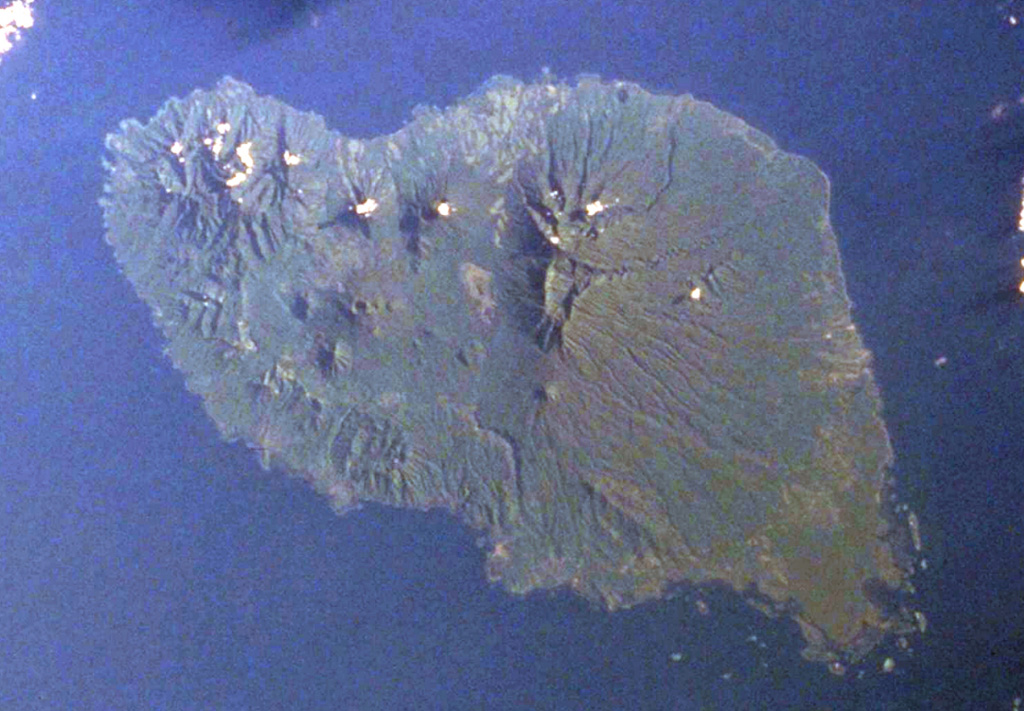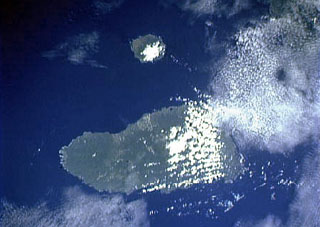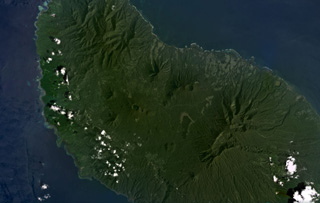

Seismicity; subsidence in flank thermal area
"Following damaging earthquakes and changes at a thermal area on Umboi Island during August, local people were concerned about possible volcanic activity. A brief visit was made to Umboi by R. W. Johnson (Bureau of Mineral Resources, Canberra) on 5 September. He reported no signs of imminent volcanic threat but recommended that an officer from Rabaul Volcano Observatory (RVO) visit Umboi for further investigations.
"On 12 September, inspection of the thermal area on the W flank of Talo volcano (on the W side of Umboi Island) indicated that no increase in temperature had occurred. However, local subsidence had taken place. This was probably due to strong shaking of the ground during the strongest earthquake on 19 August.
"Nine local earthquakes were recorded 11-14 September, two reportedly felt. These earthquakes are probably local to Umboi Island, but it is uncertain whether they are directly related to the volcano. Seismic records indicate that earthquakes were continuing at a low level in mid-September."
Information Contacts: J. Mori, RVO.
The Global Volcanism Program has no Weekly Reports available for Umboi.
Reports are organized chronologically and indexed below by Month/Year (Publication Volume:Number), and include a one-line summary. Click on the index link or scroll down to read the reports.
Seismicity; subsidence in flank thermal area
"Following damaging earthquakes and changes at a thermal area on Umboi Island during August, local people were concerned about possible volcanic activity. A brief visit was made to Umboi by R. W. Johnson (Bureau of Mineral Resources, Canberra) on 5 September. He reported no signs of imminent volcanic threat but recommended that an officer from Rabaul Volcano Observatory (RVO) visit Umboi for further investigations.
"On 12 September, inspection of the thermal area on the W flank of Talo volcano (on the W side of Umboi Island) indicated that no increase in temperature had occurred. However, local subsidence had taken place. This was probably due to strong shaking of the ground during the strongest earthquake on 19 August.
"Nine local earthquakes were recorded 11-14 September, two reportedly felt. These earthquakes are probably local to Umboi Island, but it is uncertain whether they are directly related to the volcano. Seismic records indicate that earthquakes were continuing at a low level in mid-September."
Information Contacts: J. Mori, RVO.
|
|
||||||||||||||||||||||||||||
The Global Volcanism Program is not aware of any Holocene eruptions from Umboi. If this volcano has had large eruptions (VEI >= 4) prior to 12,000 years ago, information might be found on the Umboi page in the LaMEVE (Large Magnitude Explosive Volcanic Eruptions) database, a part of the Volcano Global Risk Identification and Analysis Project (VOGRIPA).
This compilation of synonyms and subsidiary features may not be comprehensive. Features are organized into four major categories: Cones, Craters, Domes, and Thermal Features. Synonyms of features appear indented below the primary name. In some cases additional feature type, elevation, or location details are provided.
Synonyms |
||||
| Rooke Island | West Umboi Island | Ruk Island | Siassi Island | ||||
Cones |
||||
| Feature Name | Feature Type | Elevation | Latitude | Longitude |
| Barik | Stratovolcano | 1264 m | 5° 33' 25.00" S | 147° 53' 8.00" E |
| Soal | Stratovolcano | 1335 m | 5° 34' 26.00" S | 147° 54' 57.00" E |
| Talo | Stratovolcano | 1305 m | 5° 35' 54.00" S | 147° 51' 49.00" E |
| Tanglup | Cone | 1138 m | 5° 36' 6.00" S | 147° 52' 26.00" E |
| Vitiaz Knoll | Cone | -882 m | 5° 48' 52.00" S | 147° 37' 49.00" E |
Craters |
||||
| Feature Name | Feature Type | Elevation | Latitude | Longitude |
| Apalong | Crater | 1164 m | 5° 35' 53.00" S | 147° 52' 3.00" E |
| Bono | Crater | 1150 m | 5° 34' 20.00" S | 147° 55' 16.00" E |
| Pung | Crater | 1096 m | 5° 35' 36.00" S | 147° 51' 33.00" E |
 The small circular island at the top-center is Sakar, the NE-most of a chain of volcanic islands off the northern coast of Papua New Guinea. The 8 x 10 km wide island, seen in this Space Shuttle image with north to the upper left, is an incised stratovolcano with a summit crater lake. The 50-km-wide island of Umboi, whose left side is cut by a large caldera breached to the NE, fills the center of the image.
The small circular island at the top-center is Sakar, the NE-most of a chain of volcanic islands off the northern coast of Papua New Guinea. The 8 x 10 km wide island, seen in this Space Shuttle image with north to the upper left, is an incised stratovolcano with a summit crater lake. The 50-km-wide island of Umboi, whose left side is cut by a large caldera breached to the NE, fills the center of the image. The 50-km-long island of Umboi, the largest of the volcanic islands off the north coast of New Guinea, is seen in this Space Shuttle image (N is to the top-right). A large 13 x 17 km caldera is visible in the northern half of the island and is breached to the NE (top center). Three post-caldera cones with summit crater lakes (left center) are visible on the smooth-surfaced caldera floor. The large eroded massif (right center) is an older volcanic complex, as is the dissected northern tip of the island (upper left).
The 50-km-long island of Umboi, the largest of the volcanic islands off the north coast of New Guinea, is seen in this Space Shuttle image (N is to the top-right). A large 13 x 17 km caldera is visible in the northern half of the island and is breached to the NE (top center). Three post-caldera cones with summit crater lakes (left center) are visible on the smooth-surfaced caldera floor. The large eroded massif (right center) is an older volcanic complex, as is the dissected northern tip of the island (upper left). Umboi Island is around 50 km long in the NW-SE direction and has volcanic features visible in the NW, in the center of this January 2021 Planet Labs satellite image monthly mosaic (N is at the top; this image is approximately 40 km across). The larger crater near the top of the center of the island (N of the lake) is Bono of Soal volcano, and W is the eroded Barik cone. S of that is a NNW-SEE trend of craters named Pung, Talo, Apalong, and Tanglup from W to E.
Umboi Island is around 50 km long in the NW-SE direction and has volcanic features visible in the NW, in the center of this January 2021 Planet Labs satellite image monthly mosaic (N is at the top; this image is approximately 40 km across). The larger crater near the top of the center of the island (N of the lake) is Bono of Soal volcano, and W is the eroded Barik cone. S of that is a NNW-SEE trend of craters named Pung, Talo, Apalong, and Tanglup from W to E.There are no samples for Umboi in the Smithsonian's NMNH Department of Mineral Sciences Rock and Ore collection.
| Copernicus Browser | The Copernicus Browser replaced the Sentinel Hub Playground browser in 2023, to provide access to Earth observation archives from the Copernicus Data Space Ecosystem, the main distribution platform for data from the EU Copernicus missions. |
| MIROVA | Middle InfraRed Observation of Volcanic Activity (MIROVA) is a near real time volcanic hot-spot detection system based on the analysis of MODIS (Moderate Resolution Imaging Spectroradiometer) data. In particular, MIROVA uses the Middle InfraRed Radiation (MIR), measured over target volcanoes, in order to detect, locate and measure the heat radiation sourced from volcanic activity. |
| MODVOLC Thermal Alerts | Using infrared satellite Moderate Resolution Imaging Spectroradiometer (MODIS) data, scientists at the Hawai'i Institute of Geophysics and Planetology, University of Hawai'i, developed an automated system called MODVOLC to map thermal hot-spots in near real time. For each MODIS image, the algorithm automatically scans each 1 km pixel within it to check for high-temperature hot-spots. When one is found the date, time, location, and intensity are recorded. MODIS looks at every square km of the Earth every 48 hours, once during the day and once during the night, and the presence of two MODIS sensors in space allows at least four hot-spot observations every two days. Each day updated global maps are compiled to display the locations of all hot spots detected in the previous 24 hours. There is a drop-down list with volcano names which allow users to 'zoom-in' and examine the distribution of hot-spots at a variety of spatial scales. |
|
WOVOdat
Single Volcano View Temporal Evolution of Unrest Side by Side Volcanoes |
WOVOdat is a database of volcanic unrest; instrumentally and visually recorded changes in seismicity, ground deformation, gas emission, and other parameters from their normal baselines. It is sponsored by the World Organization of Volcano Observatories (WOVO) and presently hosted at the Earth Observatory of Singapore.
GVMID Data on Volcano Monitoring Infrastructure The Global Volcano Monitoring Infrastructure Database GVMID, is aimed at documenting and improving capabilities of volcano monitoring from the ground and space. GVMID should provide a snapshot and baseline view of the techniques and instrumentation that are in place at various volcanoes, which can be use by volcano observatories as reference to setup new monitoring system or improving networks at a specific volcano. These data will allow identification of what monitoring gaps exist, which can be then targeted by remote sensing infrastructure and future instrument deployments. |
| Volcanic Hazard Maps | The IAVCEI Commission on Volcanic Hazards and Risk has a Volcanic Hazard Maps database designed to serve as a resource for hazard mappers (or other interested parties) to explore how common issues in hazard map development have been addressed at different volcanoes, in different countries, for different hazards, and for different intended audiences. In addition to the comprehensive, searchable Volcanic Hazard Maps Database, this website contains information about diversity of volcanic hazard maps, illustrated using examples from the database. This site is for educational purposes related to volcanic hazard maps. Hazard maps found on this website should not be used for emergency purposes. For the most recent, official hazard map for a particular volcano, please seek out the proper institutional authorities on the matter. |
| IRIS seismic stations/networks | Incorporated Research Institutions for Seismology (IRIS) Data Services map showing the location of seismic stations from all available networks (permanent or temporary) within a radius of 0.18° (about 20 km at mid-latitudes) from the given location of Umboi. Users can customize a variety of filters and options in the left panel. Note that if there are no stations are known the map will default to show the entire world with a "No data matched request" error notice. |
| UNAVCO GPS/GNSS stations | Geodetic Data Services map from UNAVCO showing the location of GPS/GNSS stations from all available networks (permanent or temporary) within a radius of 20 km from the given location of Umboi. Users can customize the data search based on station or network names, location, and time window. Requires Adobe Flash Player. |
| DECADE Data | The DECADE portal, still in the developmental stage, serves as an example of the proposed interoperability between The Smithsonian Institution's Global Volcanism Program, the Mapping Gas Emissions (MaGa) Database, and the EarthChem Geochemical Portal. The Deep Earth Carbon Degassing (DECADE) initiative seeks to use new and established technologies to determine accurate global fluxes of volcanic CO2 to the atmosphere, but installing CO2 monitoring networks on 20 of the world's 150 most actively degassing volcanoes. The group uses related laboratory-based studies (direct gas sampling and analysis, melt inclusions) to provide new data for direct degassing of deep earth carbon to the atmosphere. |
| Large Eruptions of Umboi | Information about large Quaternary eruptions (VEI >= 4) is cataloged in the Large Magnitude Explosive Volcanic Eruptions (LaMEVE) database of the Volcano Global Risk Identification and Analysis Project (VOGRIPA). |
| EarthChem | EarthChem develops and maintains databases, software, and services that support the preservation, discovery, access and analysis of geochemical data, and facilitate their integration with the broad array of other available earth science parameters. EarthChem is operated by a joint team of disciplinary scientists, data scientists, data managers and information technology developers who are part of the NSF-funded data facility Integrated Earth Data Applications (IEDA). IEDA is a collaborative effort of EarthChem and the Marine Geoscience Data System (MGDS). |